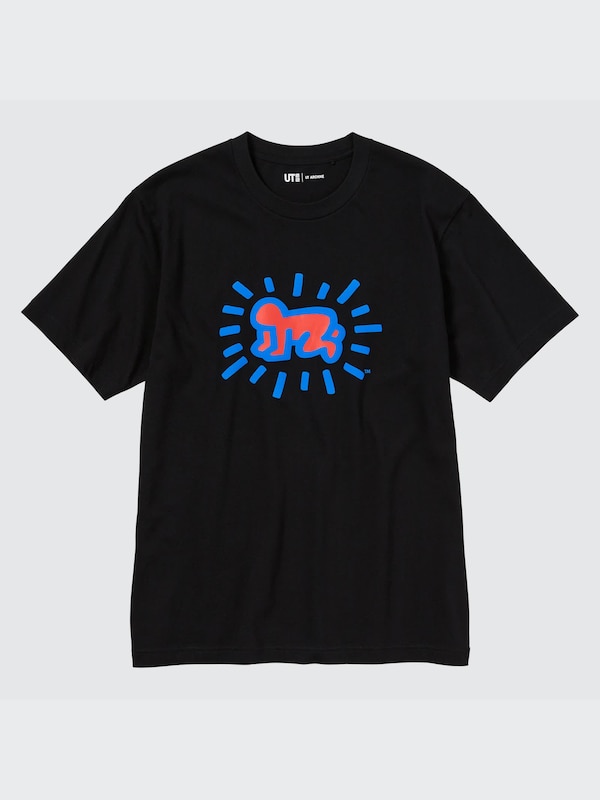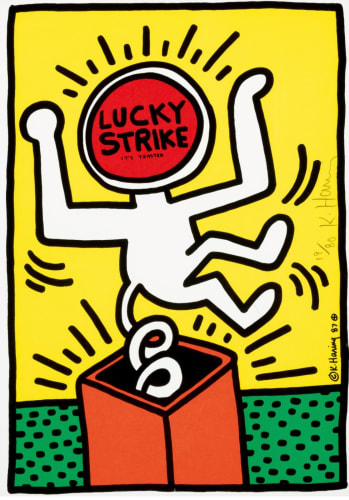Few artists have straddled the boundary between fine art and mass appeal as gracefully and deliberately as Keith Haring. From chalk drawings in New York subways to international brand campaigns, Haring’s art has consistently echoed a singular, inclusive message: art is not reserved for the elite—it belongs to everyone. Through a wide range of commercial ventures, from Absolut Vodka to Lucky Strike, and later UNIQLO, Swatch, and more, Haring built and sustained an artistic legacy grounded in accessibility, activism, and universal visual language.
Art Meets Commerce: Haring’s Philosophy
Keith Haring emerged in the 1980s art scene with a vibrant visual vocabulary—radiant babies, barking dogs, dancing figures—that was instantly recognisable and resonated with people from all walks of life. His approach defied the exclusivity often associated with the art world. He once said, The public needs art—and it is the responsibility of a 'self-proclaimed artist' to realize that the public needs art, and not to make bourgeois art for the few.
Haring saw no contradiction between creating gallery works and engaging with commercial enterprises. To him, both were tools for mass communication, capable of spreading messages about love, justice, AIDS awareness, and anti-racism. His brand collaborations were not opportunistic, but strategic extensions of his mission.
Absolut Haring: Art in a Bottle
In 1986, Keith Haring joined the ranks of artists like Andy Warhol in contributing to the Absolut Vodka Artist Series. The campaign, Absolut Haring, featured his bold, kinetic figures wrapped around the familiar bottle silhouette. Unlike many commercial collaborations that dilute an artist’s voice, Haring’s contribution retained his integrity—radiating energy, movement, and the universal appeal of his graffiti-influenced style.
Absolut Vodka’s campaigns were known for elevating artists while also democratizing art by placing it in widely circulated advertising. Haring’s involvement signaled a shift in how contemporary art could live outside the gallery and reach millions through popular media. It aligned perfectly with his populist vision, turning an everyday product into a vessel of visual activism.

Lucky Strike: The Cigarette Box as Canvas
Also in 1986, Haring was commissioned to design Lucky Strike cigarette packaging for a campaign in Europe. The result: the Lucky Strike portfolio a riot of bright colors and dynamic outlines enveloping the box. While the choice of a cigarette brand might seem controversial by today’s standards, it echoed the spirit of the 1980s—an era of bold commercial experimentation in art.
Importantly, Haring used even this project as a platform to reinforce his ideas. He transformed the mundane into something joyous and vibrant, using the opportunity to inject his vision into everyday spaces—grocery stores, street kiosks, and people’s pockets. In doing so, he helped to collapse the barrier between "high" and "low" art.

The Pop Shop: Art as Wearable Democracy
Beyond one-off campaigns, Haring took his philosophy to a radical new level in 1986 when he opened the Pop Shop in SoHo. There, he sold posters, T-shirts, magnets, toys, and more—all emblazoned with his artwork and priced for the general public. The Pop Shop embodied the idea that art could be playful, ubiquitous, and democratic.
Although some critics accused him of "selling out," Haring maintained that making his work available to everyone, especially young people and those outside the traditional art scene, was a moral imperative. “I could earn more money if I just painted a few things and jacked up the price,” he said, “but my sense of social responsibility won’t let me do that.”
The Pop Shop was not just retail—it was a political statement. It allowed people to carry his messages about love, unity, and resistance into the world, not on museum walls, but on tote bags and T-shirts.
Posthumous Partnerships: Continuing the Mission
Following Haring’s death from AIDS-related complications in 1990, the Keith Haring Foundation was established to manage his estate and continue his work, particularly in areas of AIDS awareness and children's programs. The Foundation has since formed numerous partnerships that expand on his vision of art for all.
UNIQLO: Art for Every Wardrobe
In 2014, Japanese fashion giant UNIQLO launched a series of collaborations featuring Haring’s iconic artwork on affordable clothing. The campaign was global, with shirts, hoodies, and accessories that allowed wearers to engage with Haring’s art in a highly personal and public way.
UNIQLO’s commitment to accessibility and quality made it an ideal match for Haring’s ethos. The collaboration ensured that Haring’s imagery—once scrawled on subway walls—could now be seen across urban centers worldwide, worn by people of every age and background.

Swatch: Timepieces of Expression
Swatch, known for its playful embrace of art and design, released several Keith Haring collections posthumously, starting in the mid-1990s and continuing into the 2020s. These watches, featuring everything from Radiant Babies to barking dogs, became collectible timepieces that were still affordable and widely available.
Swatch’s platform aligned closely with Haring’s ideals: wearable, everyday art that was both expressive and inclusive. The fact that these watches are sold in airports, shopping malls, and high streets worldwide makes them another touchstone of Haring’s belief that art is for everybody.

Other Collaborations and Enduring Influence
In addition to UNIQLO and Swatch, Haring’s imagery has appeared on Converse sneakers, Coach bags, MAC Cosmetics packaging, and even the Google homepage. Each of these partnerships, curated through the Haring Foundation, is carefully chosen to maintain the artist’s legacy of inclusivity and activism.
MAC’s 2022 Viva Glam campaign, for instance, tied directly into HIV/AIDS funding—a cause close to Haring’s heart. Coach’s 2021 collection integrated his art into high-fashion leather goods while simultaneously promoting LGBTQ+ youth support initiatives. These projects don’t just echo his aesthetic—they continue his activism.
The Message Endures
Keith Haring’s commercial ventures were never about commerce for commerce’s sake. They were acts of cultural subversion—inserting radical art and social commentary into the heart of mainstream consumer life. By collaborating with brands, Haring didn’t compromise his message; he amplified it. He understood that mass visibility could be just as potent as museum curation, if not more so.
Today, whether through a Swatch on a teenager’s wrist or a UNIQLO hoodie in Tokyo, Haring’s art still radiates. It still dances, still warns, still celebrates. In a world increasingly divided by class, access, and privilege, Haring’s partnerships stand as a vibrant reminder that art can be, and should be, for everyone.
Discover Keith Haring signed prints for sale and contact our New York and London galleries via info@guyhepner.com for latest availabilities.
